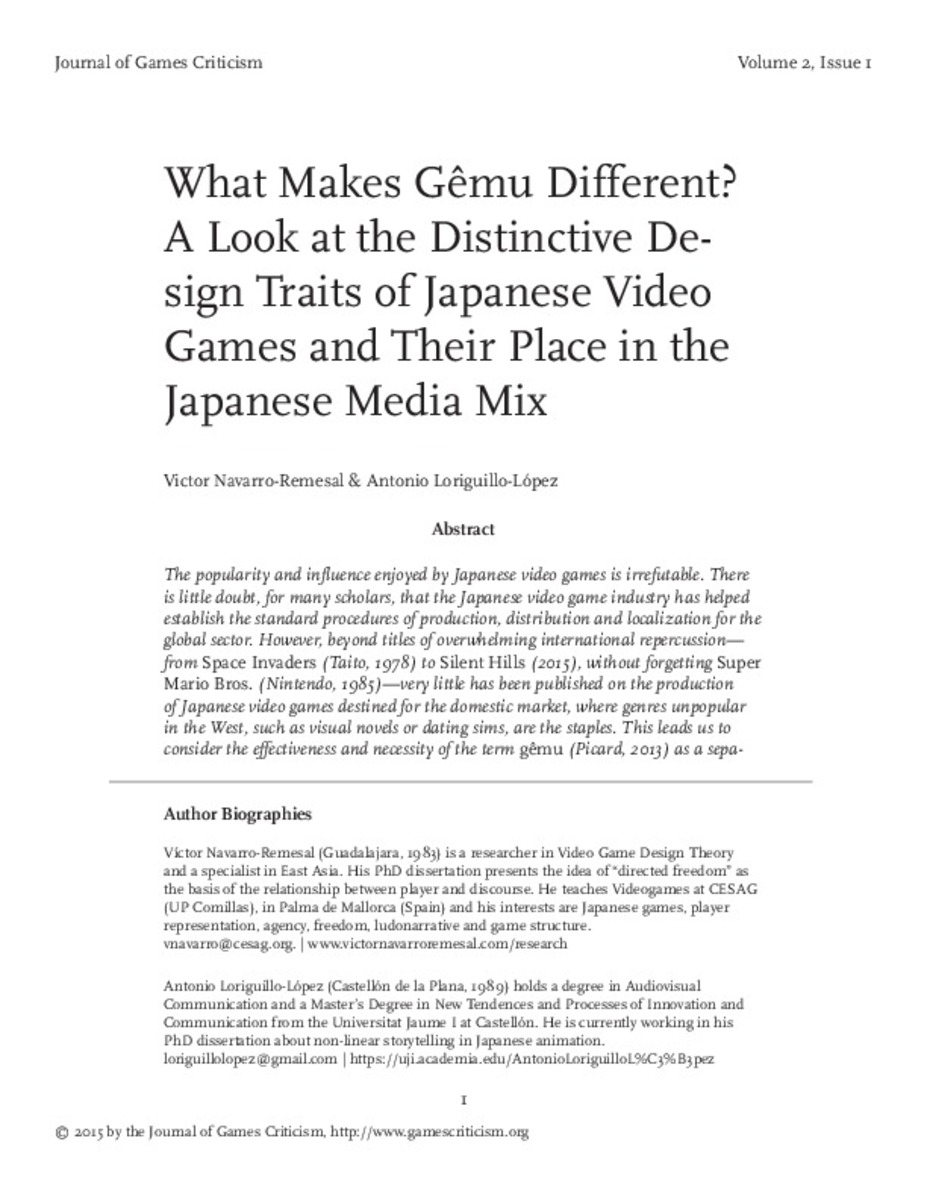Mostrar el registro sencillo del ítem
What Makes Gêmu Different? A Look at the Distinctive Design Traits of Japanese Video Games and Their Place in the Japanese Media Mix
| dc.contributor.author | Navarro Remesal, Víctor | |
| dc.contributor.author | Loriguillo López, Antonio | |
| dc.date.accessioned | 2016-09-07T10:13:01Z | |
| dc.date.available | 2016-09-07T10:13:01Z | |
| dc.date.issued | 2015-01 | |
| dc.identifier.citation | NAVARRO-REMESAL, Victor; LORIGUILLO-LÓPEZ, Antonio. What Makes Gêmu Different? A Look at the Distinctive Design Traits of Japanese Video Games and Their Place in the Japanese Media Mix. Journal of Games Criticism, 2015, vol. 2, no 1, p. 1-18. | ca_CA |
| dc.identifier.issn | 2374-202X | |
| dc.identifier.uri | http://hdl.handle.net/10234/162253 | |
| dc.description.abstract | The popularity and influence enjoyed by Japanese video games is irrefutable. There is little doubt, for many scholars, that the Japanese video game industry has helped establish the standard procedures of production, distribution and localization for the global sector. However, beyond titles of overwhelming international repercussion—from Space Invaders (Taito, 1978) to Silent Hills (2015), without forgetting Super Mario Bros. (Nintendo, 1985)—very little has been published on the production of Japanese video games destined for the domestic market, where genres unpopular in the West, such as visual novels or dating sims, are the staples. This leads us to consider the effectiveness and necessity of the term gêmu (Picard, 2013) as a separate category for the critique of Japanese video games. In this paper, we start with Picard’s contribution, which defined the socio-economic variables of gêmus, and set out to explore their design and aesthetic features in the broad context of Japanese entertainment products. To do so, we try to delimit the role that gêmu have played in the expansion of Cool Japan and the synergies between them, manga and anime within the Japanese media mix. This allows us to describe a list of particular aesthetic and creative features of gêmu; a set of characteristics which, although not universal, can be usefully applied in game criticism to provide a better understanding of the particular features of gêmu. | ca_CA |
| dc.format.extent | 17 p. | ca_CA |
| dc.format.mimetype | application/pdf | ca_CA |
| dc.language.iso | eng | ca_CA |
| dc.publisher | Rensselaer Polytechnic Institute | ca_CA |
| dc.relation.isPartOf | Journal of Games Criticism Volume 2, Issue 1, January 2015 | ca_CA |
| dc.rights | © 2013 - 2015 Journal of Games Criticism, all rights reserved. | ca_CA |
| dc.rights.uri | http://rightsstatements.org/vocab/InC/1.0/ | * |
| dc.subject | video games | ca_CA |
| dc.subject | Japanese video game industry | ca_CA |
| dc.subject | gêmu | ca_CA |
| dc.title | What Makes Gêmu Different? A Look at the Distinctive Design Traits of Japanese Video Games and Their Place in the Japanese Media Mix | ca_CA |
| dc.type | info:eu-repo/semantics/article | ca_CA |
| dc.rights.accessRights | info:eu-repo/semantics/openAccess | ca_CA |
Ficheros en el ítem
Este ítem aparece en la(s) siguiente(s) colección(ones)
-
COM_Articles [812]







